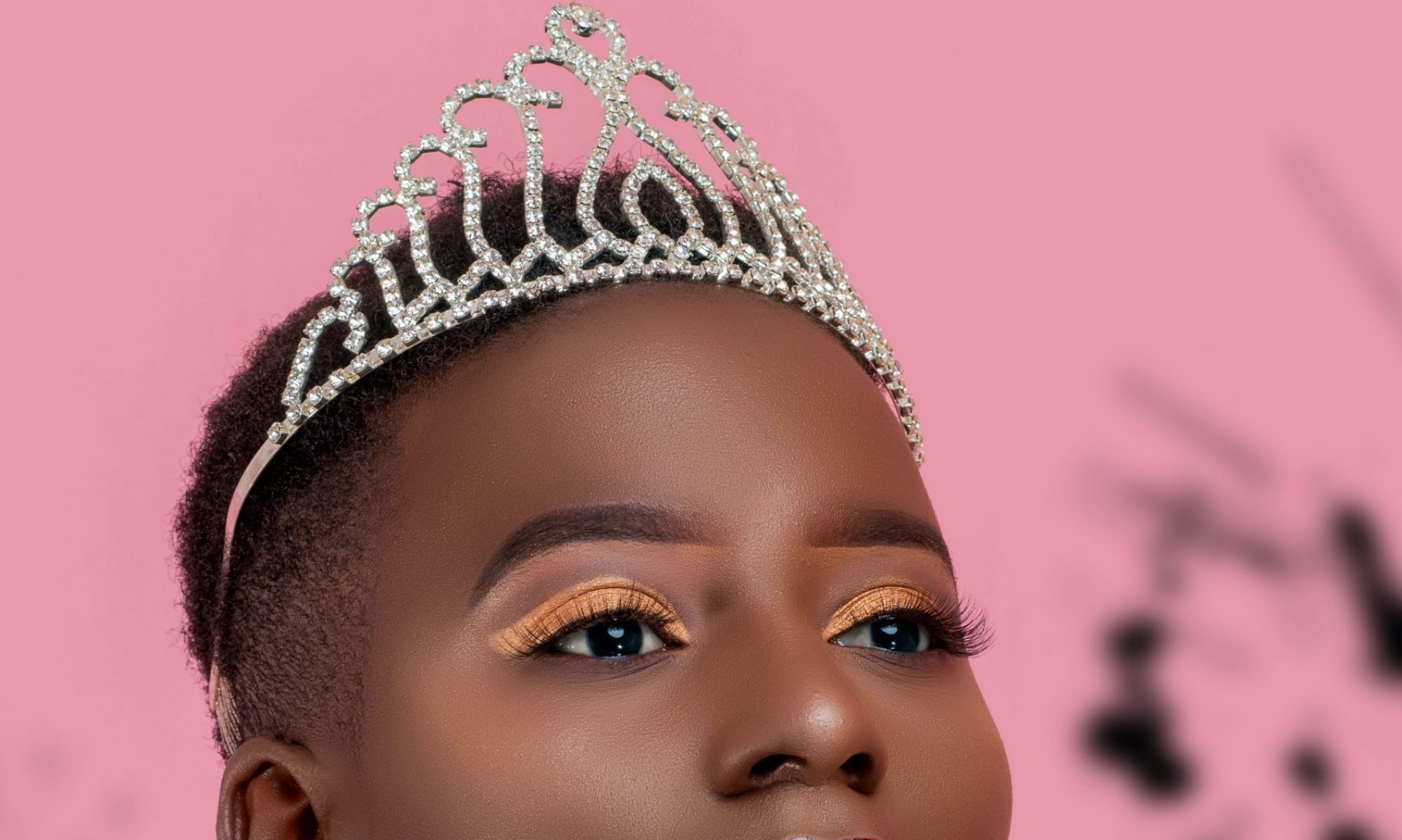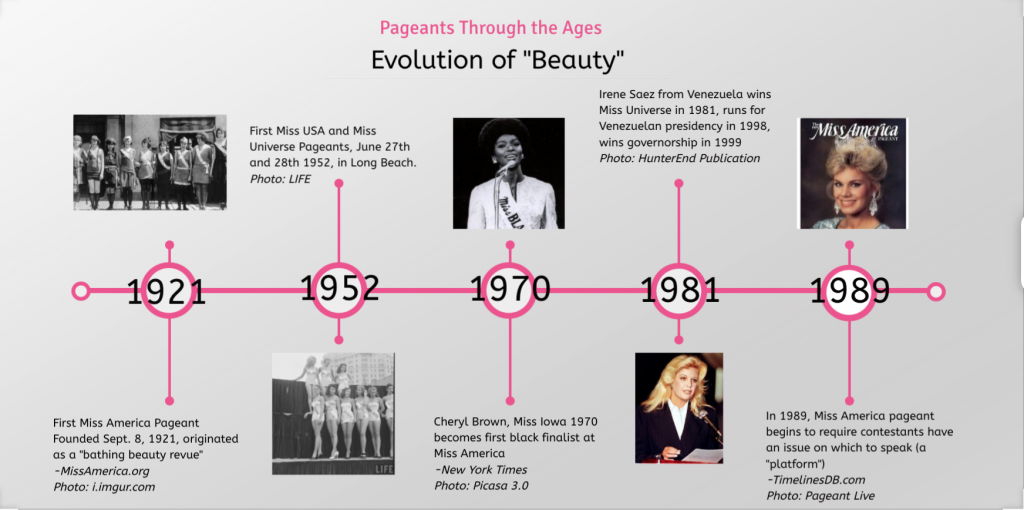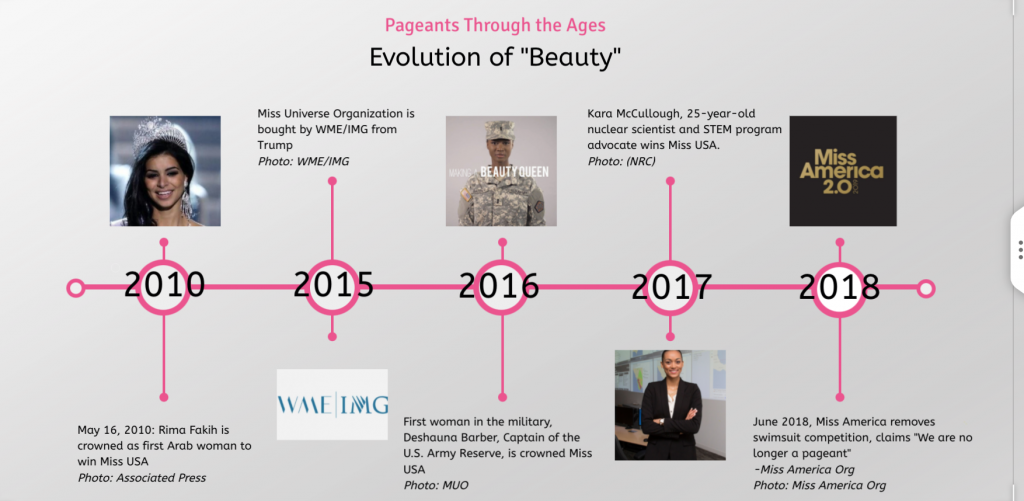The Evolution of Beauty Explained through Pageantry Over Time
Dazzling gowns and sparkling crowns may come to mind when you think of the word pageant; a place where beautiful women gather to parade on stage, maybe share a tap dance, and walk away with a banner and flowers. Pageants have evolved over time from their original purpose into programs with different values as you will hear explained by competitors and professionals in the business. They discuss the delta between the perception of their community and its activity and the evolved purpose pageants and those competing in them serve. The point of pageants has shifted over time from exterior credentials to talent and intellect as explained by the community and organizations themselves—one can also observe the change through the media that broadcasts them with changes in ownership, networks, and more broadly, societal values as a whole with the times. Miss California USA and Miss Florida USA Executive Producer Robin Ross Fleming exemplifies the disconnect between society’s perception of pageantry and what those enthralled in the experience want others to understand. She said the sport is evolving with the times as beauty has. “Twenty years ago, winning a pageant was based on your outer presentation, your ability to use hair/makeup skills to present yourself as a ’stereotypical’ beauty,” she said. “Now, we recognize beauty as the energy inside that informs the outer appearance, which requires a lot more skills than a makeup brush or hairspray. The stereotypes have been shattered, but the messaging to the public hasn’t overcome the stereotypes…YET.”
Through research, you can see the stereotype was once justified because of the nature of pageants when they first originated. In 1921, the first Miss America pageant was held as a “bathing suit beauty review.” The contestants were scored on their physique and cosmetic beautifying technique. Over the years, the competition inherited talent and interview as portions of the competition but were still perceived as ‘beauty pageants’ up until the last couple decades. This does not mean beauty isn’t a component in the pageants still today, but organization directors claim that everyone in the pageant competing is beautiful on the outside, so judges look to decide winners based on their inner standout qualities. Today, the Miss America Organization values strong speaking skills, highly active engagement in one’s community, personal talent, and educational dedication in its contestants.
JJ Smith with Winnerviews, noted interview coach with decades of experience in the industry, shared his guess as to why pageants may get a bad rap. “The most inaccurate negative opinions of pageant contestants generally come from those who simply do not know the true facts and have succumbed to the inaccuracies that have been repeated through the years,” he said. “Many people are surprised to learn that the Miss America Organization is one the largest providers of college scholarships not just in the United States, but the world.”
Miss America has been broadcast since the origination in 1921 and when Miss USA was founded in 1952, broadcasting its production annually as well. The media is the only way those outside the community get their understanding of pageants. Those inside the business say the media is not up-to-date with current pageant values and missions. Shows like TLC’s Toddlers & Tiaras, and the chosen portions of competition that are broadcast during national pageants like Miss USA are claimed to be leaving out the evolved purpose of pageants today. Fleming points out she understands it is difficult to broadcast an entire weekend of pageant events, so shows will tend to focus on the most dramatic, attractive footage, and leave out the wholesome moments, and conversations of intellectual substance. “The media seems to be about 20 years behind the reality of the ‘pageant’ experience,” she said. “Perhaps changing the term ‘pageant’ to ‘personal competition’ would help the media to understand the direction of these events as we have already begun to do in the pageants we produce.”
Like the Miss USA and Miss America pageants, all other systems generally value community service as part of their criteria. This is the part of the pageant that goes unseen, along with the parts where the women get to speak, and we get to know them Fleming explained. In the three biggest nationally and internationally broadcast pageants, Miss America, Miss USA, and Miss Universe, the interview portion, paralleled to a job interview with a résumé and career goal discussion, as well as service, occurs before the live show and is not generally filmed or broadcast. The last few years, however, the organizations have shown more footage of these processes, and allowed more chances for the contestants to speak on stage about their community service platforms and occupations. Halle Thompson, a seasoned high school pageant competitor and Miss California High School America 2018, says the interview skills, service, and connections made are the reasons she competes. “Pageants are an outlet for me to perform on stage and make connections with others,” she said. “In interview portions of the competition, I am able to connect with judges and on a larger scale. I have created a network of people across the U.S. that I believe will be able to help me with future endeavors. My purpose for pageantry was originally to gain confidence in myself and improve my speaking and social skills. However, through my pageant career, I have found what I am passionate about which is giving back, public speaking, and empowering others.”
The contestants and professionals in the business say pageants can be so valuable in personal development because you can apply the skills learned in serving one’s community, public speaking, and answering questions to real life circumstances. Smith stated “I gain an incredible personal satisfaction in knowing that the techniques that I impart to my clients are ones that will not just serve them in being their best for the next pageant but will serve them for a lifetime. They are not simply current and immediate lessons, but life lessons.”
Diversity is increasing in the pageant world with women of all trades and educational backgrounds showcasing their scholarship. Thompson points out that many of the women who compete in pageants are accomplished scientists, lawyers, doctors, and teachers. “They just happen to be beautiful and have the ability to walk down a runway in 6-inch heels.” This diversity in careers was demonstrated in recent years of the Miss USA competition. Deshauna Barber, Miss USA 2016, was the first ever crowned captain in the U.S. Army Reserve. Her successor, Kara McCullough, Miss USA 2017, is a scientist at the Nuclear Regulatory Commission. And just last December, Miss America 2020, Camille Schrier won the national pageant with a chemical reaction science experiment demonstration as her talent. Not only have these women brought diversity to the goals and career paths of the women in pageants, but they have contributed to exterior diversity as well.
For many years, there was no diversity in winners crowned in the traditional beauty pageants. There was a certain image of smooth, straight or soft curly hair, thin, and generally Caucasian. Over the years, women of color began to be crowned, but there was still not enough equal representation in semi-finalists since recent years. Miss Universe began to pick the top 20 finalists now by region so there is a fair chance for all countries. In 2016, and 2017, Barber and McCoullough became the first back-to-back African American competitors from D.C. to win the title. In 2018, Angela Ponce, Miss Spain, became the first transgender contestant to walk the Miss Universe stage and in 2019, for the first time, all four major national and international titleholders who won, Miss USA, Miss Teen USA, Miss Universe, and Miss America were African American women who proudly wore and wear their natural hair. Miss Universe 2020, Zozibini Tunzi shared this message on stage moments before capturing the crown. “I grew up in a world where a woman who looks like me, with my kind of skin and my kind of hair, was never considered to be beautiful,” she said. “And I think that it is time that that stops today. I want children to look at me and see my face. I want them to see their faces reflected I mine.”
Halle Thompson found confidence in her half-Asian culture with the development of diversity in pageants she has experienced herself. She believes that the new idea of beauty, the one that comes from within, is one that allows you to empower yourself and others. “We work hard in pageants, but we also get to build lifelong friendships with our competitors who really become like our sisters,” she said. “In pageantry, we have a saying that goes ‘real queens fix each other’s; crowns,’ which embodies the sense of friendship and sisterhood of pageantry.” With the change in what beauty means, pageants are changing what they value, and the media should therefore display these updates and improvements to better convey to the outside world. The pageant community has welcomed these long-overdue changes compatible with society’s evolution and Fleming, Smith, and Thompson all agree, they are looking forward to continually evolving and improving ideals of inner instead of outer beauty, character, and personal success not only in pageants but in the world as a whole. Fleming said, “I think what has changed the most is the emphasis on inner self-confidence and fostering empowerment to yourself and others being the key to winning, not only on stage, but in life.”



